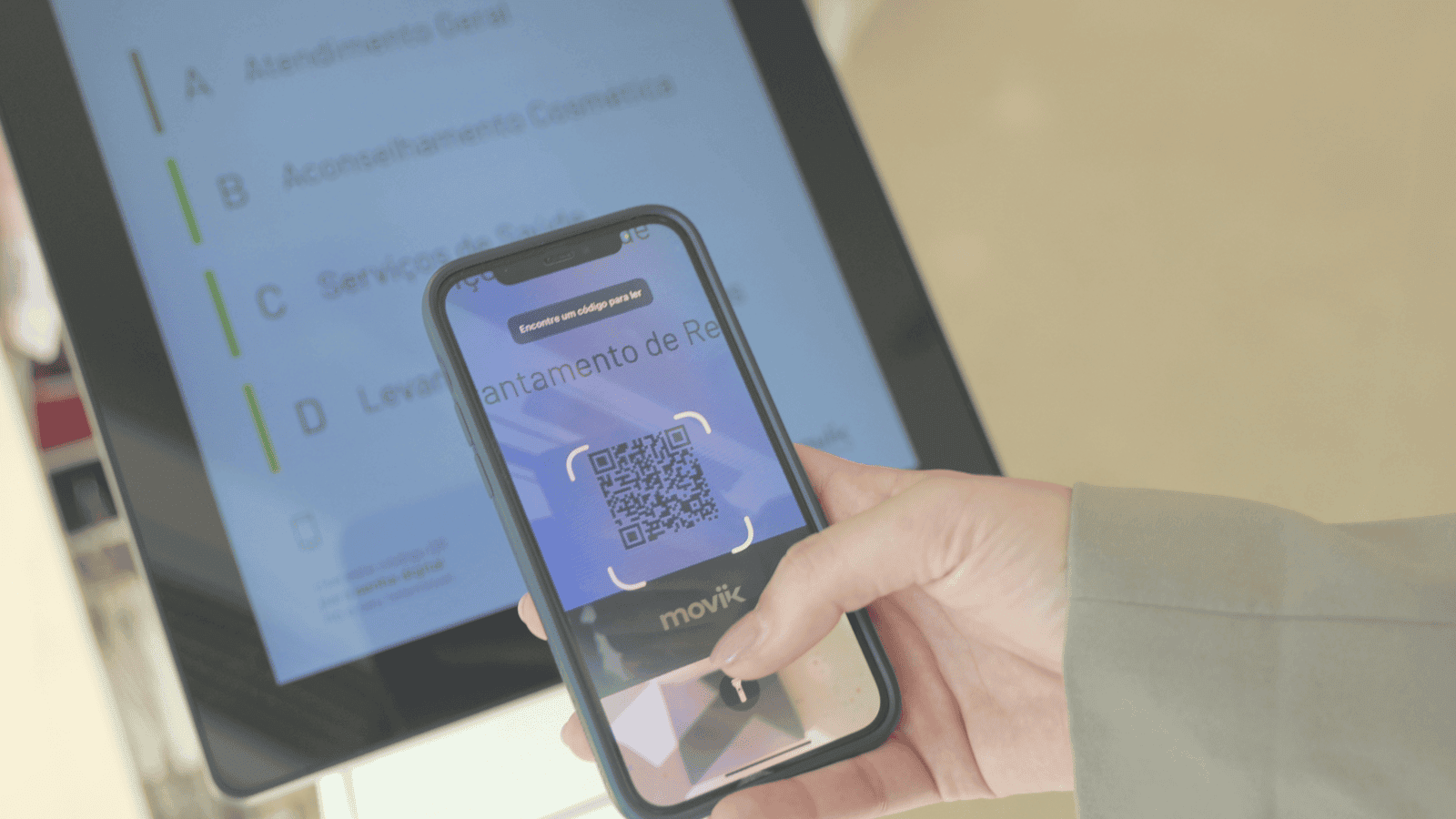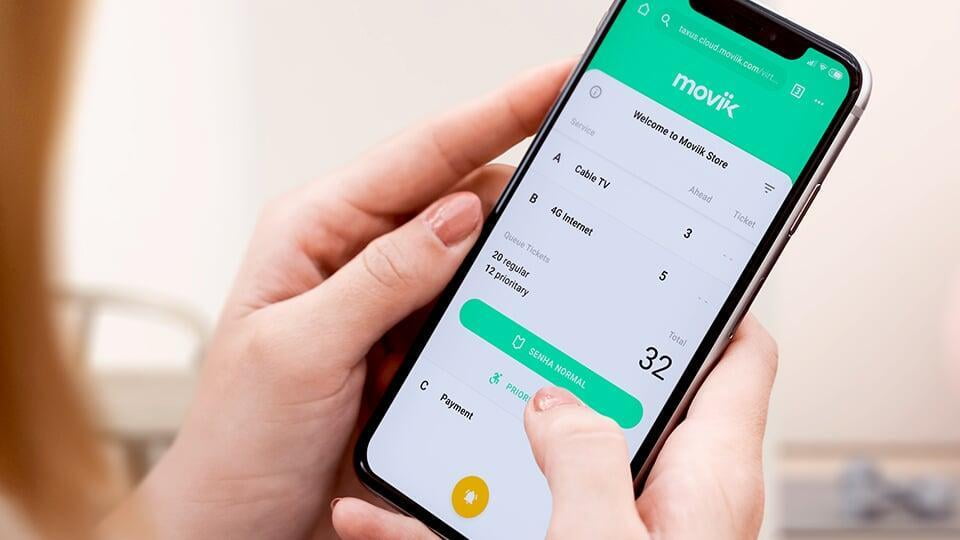Retail has changed. Today, customer experience is shaped not only at checkout or by staff interactions, but also by the moments in between — especially waiting.
And waiting has never felt longer: retail wait times have increased by 61% since 2022. Traditional lines, where customers stand still and watch the clock, no longer match the expectations of a mobile-first generation.
Enter virtual queuing, powered by digital ticketing. By shifting waiting to customers’ smartphones, retailers give shoppers freedom, reduce frustration, and even create opportunities for additional sales. What began as a convenience has now become the new retail standard.
Quick answer: what is virtual queuing in Retail?
Quick answer: what is virtual queuing in Retail?
From physical lines to digital freedom
From physical lines to digital freedom
For decades, queues were inevitable in retail, banks, or pharmacies. Smartphones have changed everything. Today, being “stuck” in line feels outdated when customers can order a ride, stream content, or transfer money instantly.
Virtual queuing is the natural response. Shoppers join a queue digitally, hold their place, and are free to use their time however they like — browsing the store, enjoying a coffee, or even stepping away. Their spot is guaranteed.
This shift is more than convenience: it’s a fundamental change in how people experience retail waiting.
Why mobile-first waiting is becoming the standard?
Why mobile-first waiting is becoming the standard?
Four key forces are driving adoption across retail:
- Rising consumer expectations: Shoppers accustomed to Uber, Netflix, and mobile banking expect the same real-time convenience in physical stores.
- Freedom and autonomy: With a digital ticket, customers control their time. No more being tied to a spot in line.
- Efficiency and transparency: Continuous updates reduce anxiety and build trust in the brand. (Research shows sporadic or one-off updates can actually increase abandonment.)
- Retailer benefits: Customers who browse while waiting are more likely to discover new products. Staff, meanwhile, gain visibility into demand and optimize service flow.
By the numbers: why retailers can’t ignore virtual queuing
By the numbers: why retailers can’t ignore virtual queuing
3 in 5 customers leave a physical line before being served.
41% of shoppers keep browsing while waiting virtually.
Retail wait times have increased 61% since 2022.
91% of people dislike being forced to install an app just to interact with a brand — proving web-first digital tickets are critical.
Together, these numbers paint a clear picture: physical queues leak revenue, while virtual queues unlock dwell time and conversion.
The hidden cost of traditional queues
The hidden cost of traditional queues
Poorly managed lines hurt more than just the immediate sale:
Lost sales: Shoppers may abandon purchases if the wait feels excessive.
Negative perception: Even great products can be overshadowed by poor waiting experiences.
Operational inefficiency: Staff spend time calming frustrated customers instead of providing service.
A bad queuing experience reduces loyalty and repeat visits. A seamless digital-first experience, on the other hand, builds trust and brand differentiation.
Virtual queueing in action: Moviik's Digital Ticket
Virtual queueing in action: Moviik's Digital Ticket
At Moviik, we designed the Digital Ticket to meet today’s retail challenges:
Customers join a queue instantly by scanning a QR code or link.
They receive real-time updates on their place in line.
They’re notified when it’s their turn, so they never lose their spot.
They enjoy freedom of movement while waiting.
For retailers, this means:
Higher customer satisfaction and stronger brand perception.
Increased revenue opportunities while customers browse.
Smarter, data-driven operations with insights into customer flow.
This isn’t just queue management software — it’s a step forward in digital-first customer experience.
How to roll out mobile-first queuing in 30 days
How to roll out mobile-first queuing in 30 days
- Entry points: Place QR codes at entrances, service desks, and collection points.
- No-app join: Use QR codes, web browser or SMS/WhatsApp to maximize adoption.
- Expectation setting: Show position + ETA at all times.
- Queue segmentation: Separate quick services (returns, pickups) from complex requests.
- Smart notifications: Ping at T-10 min, T-2 min, and grace-period fallback.
- Accessibility: Provide kiosks and printed tickets for non-smartphone users.
- Analytics tracking: Monitor Average Wait (AWT), Queue Abandonment Rate (QAR), Service Time, and Attach Rate.
Beyond queues: shaping the future of retail experience
Beyond queues: shaping the future of retail experience
Mobile-first waiting doesn’t just remove frustration. It aligns retail with how people live today: connected, digital, and time-conscious.
Virtual queuing also opens the door to future innovation:
Personalization – Deliver tailored promotions while customers wait.
Integration – Connect with loyalty programs or mobile apps.
Scalability – Extend the same technology to other industries like healthcare, finance, and transport.
FAQ: Virtual Queuing in Retail
FAQ: Virtual Queuing in Retail
What is virtual queuing?
Virtual queuing lets customers join a line digitally via QR or link, track their place in real time, and receive notifications when it’s their turn.
Do customers need to download an app?
No. Moviik’s Digital Ticket is browser-first, with optional SMS/WhatsApp alerts. Research shows 91% of customers dislike being forced to install an app.
How accurate are wait times?
Moviik provides real-time ETAs with buffer rules, ensuring customers know when to return.
What about customers without smartphones?
Moviik supports kiosks, printed tickets, and digital signage for inclusivity.
How does virtual queuing increase sales?
41% of shoppers browse more when waiting virtually, boosting discovery and purchases.
The new standard is here
The new standard is here
Waiting will always be part of retail. But how customers wait is changing forever.
With over a decade in queue management and customer experience, I can confidently say that the rise of virtual queuing in retail is one of the most important shifts in recent years.
Solutions like Moviik’s Digital Ticket empower customers to take control of their time, while giving retailers the tools to optimize service, build loyalty, and drive growth.
In today’s retail landscape, freedom is the ultimate currency. And enabling customers to wait without standing still has become one of the most valuable experiences a brand can offer.
Retail has changed. Today, customer experience is shaped not only at checkout or by staff interactions, but also by the moments in between — especially waiting.
And waiting has never felt longer: retail wait times have increased by 61% since 2022. Traditional lines, where customers stand still and watch the clock, no longer match the expectations of a mobile-first generation.
Enter virtual queuing, powered by digital ticketing. By shifting waiting to customers’ smartphones, retailers give shoppers freedom, reduce frustration, and even create opportunities for additional sales. What began as a convenience has now become the new retail standard.
Quick answer: what is virtual queuing in Retail?
Quick answer: what is virtual queuing in Retail?
From physical lines to digital freedom
From physical lines to digital freedom
For decades, queues were inevitable in retail, banks, or pharmacies. Smartphones have changed everything. Today, being “stuck” in line feels outdated when customers can order a ride, stream content, or transfer money instantly.
Virtual queuing is the natural response. Shoppers join a queue digitally, hold their place, and are free to use their time however they like — browsing the store, enjoying a coffee, or even stepping away. Their spot is guaranteed.
This shift is more than convenience: it’s a fundamental change in how people experience retail waiting.
Why mobile-first waiting is becoming the standard?
Why mobile-first waiting is becoming the standard?
Four key forces are driving adoption across retail:
- Rising consumer expectations: Shoppers accustomed to Uber, Netflix, and mobile banking expect the same real-time convenience in physical stores.
- Freedom and autonomy: With a digital ticket, customers control their time. No more being tied to a spot in line.
- Efficiency and transparency: Continuous updates reduce anxiety and build trust in the brand. (Research shows sporadic or one-off updates can actually increase abandonment.)
- Retailer benefits: Customers who browse while waiting are more likely to discover new products. Staff, meanwhile, gain visibility into demand and optimize service flow.
By the numbers: why retailers can’t ignore virtual queuing
By the numbers: why retailers can’t ignore virtual queuing
3 in 5 customers leave a physical line before being served.
41% of shoppers keep browsing while waiting virtually.
Retail wait times have increased 61% since 2022.
91% of people dislike being forced to install an app just to interact with a brand — proving web-first digital tickets are critical.
Together, these numbers paint a clear picture: physical queues leak revenue, while virtual queues unlock dwell time and conversion.
The hidden cost of traditional queues
The hidden cost of traditional queues
Poorly managed lines hurt more than just the immediate sale:
Lost sales: Shoppers may abandon purchases if the wait feels excessive.
Negative perception: Even great products can be overshadowed by poor waiting experiences.
Operational inefficiency: Staff spend time calming frustrated customers instead of providing service.
A bad queuing experience reduces loyalty and repeat visits. A seamless digital-first experience, on the other hand, builds trust and brand differentiation.
Virtual queueing in action: Moviik's Digital Ticket
Virtual queueing in action: Moviik's Digital Ticket
At Moviik, we designed the Digital Ticket to meet today’s retail challenges:
Customers join a queue instantly by scanning a QR code or link.
They receive real-time updates on their place in line.
They’re notified when it’s their turn, so they never lose their spot.
They enjoy freedom of movement while waiting.
For retailers, this means:
Higher customer satisfaction and stronger brand perception.
Increased revenue opportunities while customers browse.
Smarter, data-driven operations with insights into customer flow.
This isn’t just queue management software — it’s a step forward in digital-first customer experience.
How to roll out mobile-first queuing in 30 days
How to roll out mobile-first queuing in 30 days
- Entry points: Place QR codes at entrances, service desks, and collection points.
- No-app join: Use QR codes, web browser or SMS/WhatsApp to maximize adoption.
- Expectation setting: Show position + ETA at all times.
- Queue segmentation: Separate quick services (returns, pickups) from complex requests.
- Smart notifications: Ping at T-10 min, T-2 min, and grace-period fallback.
- Accessibility: Provide kiosks and printed tickets for non-smartphone users.
- Analytics tracking: Monitor Average Wait (AWT), Queue Abandonment Rate (QAR), Service Time, and Attach Rate.
Beyond queues: shaping the future of retail experience
Beyond queues: shaping the future of retail experience
Mobile-first waiting doesn’t just remove frustration. It aligns retail with how people live today: connected, digital, and time-conscious.
Virtual queuing also opens the door to future innovation:
Personalization – Deliver tailored promotions while customers wait.
Integration – Connect with loyalty programs or mobile apps.
Scalability – Extend the same technology to other industries like healthcare, finance, and transport.
FAQ: Virtual Queuing in Retail
FAQ: Virtual Queuing in Retail
What is virtual queuing?
Virtual queuing lets customers join a line digitally via QR or link, track their place in real time, and receive notifications when it’s their turn.
Do customers need to download an app?
No. Moviik’s Digital Ticket is browser-first, with optional SMS/WhatsApp alerts. Research shows 91% of customers dislike being forced to install an app.
How accurate are wait times?
Moviik provides real-time ETAs with buffer rules, ensuring customers know when to return.
What about customers without smartphones?
Moviik supports kiosks, printed tickets, and digital signage for inclusivity.
How does virtual queuing increase sales?
41% of shoppers browse more when waiting virtually, boosting discovery and purchases.
The new standard is here
The new standard is here
Waiting will always be part of retail. But how customers wait is changing forever.
With over a decade in queue management and customer experience, I can confidently say that the rise of virtual queuing in retail is one of the most important shifts in recent years.
Solutions like Moviik’s Digital Ticket empower customers to take control of their time, while giving retailers the tools to optimize service, build loyalty, and drive growth.
In today’s retail landscape, freedom is the ultimate currency. And enabling customers to wait without standing still has become one of the most valuable experiences a brand can offer.







